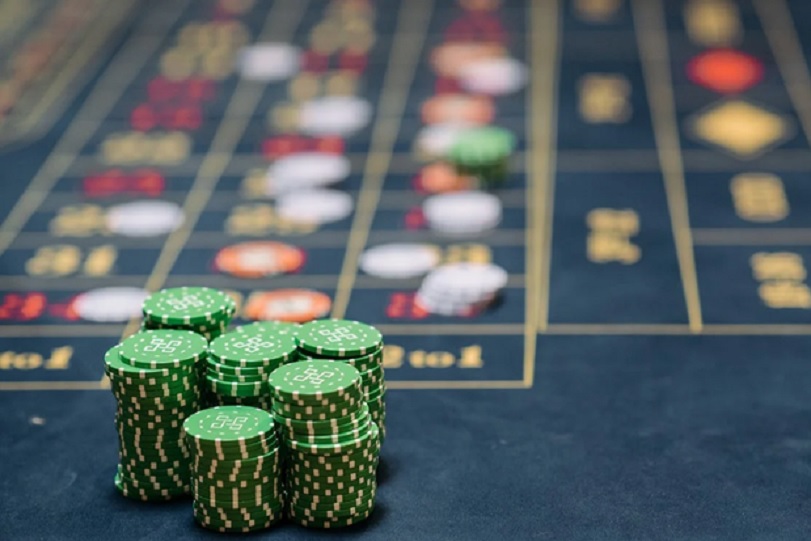Sports
Unlocking the Secrets of Roulette through Statistical Analysis

Roulette, a timeless casino game with a rich history spanning centuries, continues to captivate the attention of gamblers worldwide. Contrary to the common perception of it being merely a game of chance, roulette, in the Australian version of Roulette77, conceals a sophisticated world of statistical intricacies behind its spinning wheel and the mesmerizing trajectory of the bouncing ball.
This enduring game, which traces its origins back to 18th-century France, has evolved into a fascinating fusion of entertainment and mathematics. In the course of this article, our aim is to demystify roulette by unraveling the intricacies of statistical analysis, offering a comprehensive and clear exploration into the underlying patterns and probabilities that govern this iconic casino pastime.
By stripping away the often exaggerated glamour associated with roulette, we will embark on a journey that sheds light on the game’s mathematical foundations, allowing for a simple and formal comprehension of its dynamics.
Understanding the Basics of Roulette
Before we dive into the statistical intricacies, let’s establish a solid foundation of how roulette works. This Roulette77.in game revolves around a spinning wheel with numbered and colored pockets. The objective is to predict where the ball will land once the wheel comes to a halt. Players can place bets on specific numbers, colors, or ranges of numbers.
The Role of Probability
At its core, roulette is a game of probability. Every spin of the wheel is an independent event, meaning that the outcome of one spin does not influence the outcome of the next. The key to unraveling the mysteries of roulette lies in understanding the statistical probabilities associated with each type of bet.
Straight Bets
A straight bet on a single number may seem like a shot in the dark, but statistically, it carries a 1 in 37 (in European Roulette) or 1 in 38 (in American Roulette) chance of success. These odds are based on the number of pockets on the wheel.
Red or Black
The simplest bets in roulette involve choosing whether the ball will land on a red or black pocket. With 18 red and 18 black pockets (excluding the green zero), the probability of winning such a bet is close to 50%.
Even or Odd
Similar to the red or black bet, wagering on whether the ball will land on an even or odd number provides nearly a 50% chance of winning.
Statistical Analysis in Practice
Now that we’ve established the groundwork, let’s explore how statistical analysis comes into play. One common strategy is the Martingale System, where players double their bet after each loss. While this approach may seem foolproof, it’s essential to acknowledge its limitations. In reality, no betting system can alter the fundamental odds of the game.
In the world of statistics, variance and expected value play pivotal roles. Variance measures how far a set of numbers are spread out from their average, while the expected value represents the average outcome of a series of similar events.
In roulette, understanding the variance of different bets helps players manage their bankroll. Bets with higher variance, such as straight bets, can lead to significant wins or losses, making them riskier. On the other hand, bets with lower variance, like even or odd, provide a steadier, albeit smaller, stream of wins.
In the fast-paced world of casinos, where excitement and uncertainty often reign supreme, adopting a calculated approach to roulette can be a game-changer. By embracing statistical analysis, players can make informed decisions and navigate the roulette table with a clearer understanding of the underlying probabilities.
In essence, roulette is not merely a wheel of chance; it is a mathematical playground where statistics come to life. As we’ve explored the basics of probability, the Martingale System, and the significance of variance and expected value, it becomes evident that a simple and formal understanding of statistical concepts can empower players in their quest for success.
So, the next time you find yourself at the roulette table, remember that behind the spinning wheel and the bouncing ball lies a world of numbers and probabilities waiting to be deciphered. With a calculated approach and a basic understanding of statistical analysis, you can elevate your roulette experience from a game of chance to a strategic pursuit of favorable odds.
Sports
AFCON 2025: Eric Chelle Lists Five New Players as Nigeria Aims Fourth Title

By Adedapo Adesanya
The coach of Nigeria’s Super Eagles, Mr Eric Chelle, named five uncapped players in a 28-man squad for the Africa Cup of Nations (AFCON) set to start in Morocco on December 21.
Two former African Footballer of the Year winners, Ademola Lookman and Victor Osimhen, will be looking to change the country’s fortune and win the trophy that slipped the grasp of the Super Eagles earlier this year in Cote D’ Ivoire.
While some expected names made the list, a few others were absent, including strikers Victor Boniface and Tolu Arokodare, who were not picked. Centre-back Benjamin Fredericks and fullback Ola Aina, are injured while captain William Troost-Ekong announced his retirement from international football after last month’s World Cup playoffs.
However, uncapped right back Ryan Alebiosu, midfielders Ebenezer Akinsanmiro, Tochukwu Nnadi and Usman Muhammed and striker Salim Fago Lawal were included.
The Super Eagles open their Group C campaign on December 23 against Tanzania in Fes, then face Tunisia four days later and Uganda on December 30.
The Super Eagles went all the way to the final of the last AFCON before losing 1-2 to the host, Cote d’Ivoire, in 2024. They now will be aiming to go one step better in the next tournament where they will be going for their fourth crown.
Mr Chelle will be aiming to join Mr Otto Gloria (1980), Mr Clemens Westerhof (1994) and the late Stephen Keshi (2013), in the league of coaches to win the AFCON trophy for Nigeria.
The host nation Morocco will lead Group A alongside Mali, Zambia, and Comoros.
The Group B is also packed with heavyweights consisting of Egypt, South Africa, Angola and Zimbabwe who will have a lot to prove in the group.
In Group D, 2021 champions Senegal will battle it out with DR Congo, Benin, and Botswana, while Group E sees Algeria drawn against Burkina Faso, Equatorial Guinea, and Sudan.
Squad
Goalkeepers: Stanley Nwabali (Chippa United), Amas Obasogie (Singida Black Stars), Francis Uzoho (Omonia Nicosia)
Defenders: Ryan Alebiosu (Blackburn Rovers), Chidozie Awaziem (Nantes), Semi Ajayi (Hull City), Calvin Bassey (Fulham), Igoh Ogbu (Slavia Prague), Bruno Onyemaechi (Olympiakos), Bright Osayi-Samuel (Birmingham City), Zaidu Sanusi (FC Porto)
Midfielders: Ebenezer Akinsanmiro (Pisa), Fisayo Dele-Bashiru (Lazio), Alex Iwobi (Fulham), Usman Muhammed (Ironi Tiberias), Wilfred Ndidi (Beşiktaş), Tochukwu Nnadi (Zulte Waregem), Raphael Onyedika (Club Brugge), Frank Onyeka (Brentford)
Forwards: Akor Adams (Sevilla, Spain), Samuel Chukwueze (Fulham), Cyriel Dessers (Panathinaikos), Chidera Ejuke (Sevilla), Salim Fago Lawal (Istra 1961), Ademola Lookman (Atalanta), Paul Onuachu (Trabzonspor), Victor Osimhen (Galatasaray), Moses Simon (Paris FC).
Sports
GameZone Online Arcade Signals a New Direction for Digital Play

The GameZone Online Arcade now shapes a clear path for modern digital entertainment because many Filipino players see it as a reliable space for relaxed sessions. The section continues to attract users who want simple play that fits their daily routines without forcing them into high-pressure environments. This shift reveals something important about the evolving culture around GameZone. It shows that players want stability more than spectacle and structure more than noise. The Online Arcade answers this need with a design that respects time, mood, and attention. It also reflects the broader movement toward digital spaces that understand the rhythm of local gaming habits.
The Growing Importance of Calm Play in a Fast Digital World
Online gaming once grew through heavy visuals and fast competition, yet the rising influence of the GameZone Online Arcade shows a noticeable change in user priorities. Players today want comfort after long hours of work and constant digital noise. The Online Arcade provides that comfort through games built with clean mechanics and simple structures. This shift deserves attention because it shows how modern players choose their entertainment.
Many players now favor short sessions that give them room to breathe. The Online Arcade supports this pattern through titles that welcome users at any time of the day. The section does not compete for long hours. It respects short breaks. This approach creates a meaningful bond between players and the platform because it supports real life instead of escaping from it.
The clean interface strengthens this trend. The layout removes confusion and gives players immediate clarity. The predictable format lets new users understand each game without anxiety. Returning users feel grounded because the experience never drifts from the calm structure they trust. This steady design gives the Online Arcade a cultural presence inside the GameZone community.
The appeal of calm digital play cannot be ignored. It reflects the pressure of modern life and the need for balanced entertainment that does not add stress. The Online Arcade has become that space, and its popularity shows how players redefine their expectations with each passing month.

Why the Online Arcade Matters in the GameZone Identity
The Online Arcade now stays at the center of GameZone culture because it represents the values many players care about. It provides accessible entertainment without forcing users through complicated choices. It offers short gameplay that aligns with modern schedules. It stands as a reminder that online gaming does not have to be intense to be meaningful.
In many online groups, GameZone players often share their favorite Online Arcade titles because they are easy to describe and easier to recommend. The simplicity of the games creates shared language within these communities. People do not need special knowledge to discuss the experience. This connection builds unity in the fragmented world of digital entertainment.
The structure of the section reinforces the GameZone identity. The stable performance across devices allows players to shift between screens without losing rhythm. This reliability strengthens trust in the platform because many Filipino users rely on their phones for daily play. They need an experience that remains steady even as they move through different environments.
The Online Arcade also helps players navigate new titles without pressure. The gradual learning curve supports the idea that digital play should remain friendly, especially for people who do not have time for deep gaming sessions. This atmosphere helps GameZone welcome new users every day because the entry point remains simple and welcoming.
The growth of the Online Arcade shows that simplicity is not a weakness. It is a feature that resonates with the needs of the modern player. This section stays relevant because it understands that entertainment must adapt to real life, not escape from it.
The Balance Between Engagement and Ease in Daily GameZone Use
Many players form daily routines inside the Online Arcade because the section creates a stable pathway through the platform. The games require only a few minutes, yet those minutes create a sense of connection. This rhythm supports the changing needs of players who seek breaks instead of marathons. It also allows the Online Arcade to remain part of everyday life.
The visual consistency strengthens this daily habit because players do not need to adjust to new designs every time they enter a game. The layout remains clear, which encourages people to experiment with different titles without feeling lost. This consistency shows that GameZone understands how users interact with digital spaces.
Some players shift between Online Arcade titles and the casino content of GameZone. They do this because the platform gives them choices that match their energy for the day. When they want a focused session, they visit the casino features. When they want a calm moment, they return to the Online Arcade. This flexibility has become an important trait of GameZone’s identity.
The stable performance across devices also supports daily use. Many players move through varied environments, from commutes to workspaces to homes. They expect their games to function without issues. GameZone meets this expectation with a design that keeps the Online Arcade responsive at all times.
The daily presence of the Online Arcade in the lives of many Filipino players shows that digital habits are shaped by comfort and consistency. People want reliable entertainment that welcomes them without demand. The section delivers that, and its growth reflects this truth.
Why Online Arcade Engagement Continues to Rise
The steady rise of Online Arcade engagement reveals an important shift in the way digital communities evolve. Many platforms chase complexity, but GameZone shows that clarity and accessibility hold lasting value. The Online Arcade remains relevant because it continues to offer simple play that respects the user’s time.
Returning users rely on the familiar mechanics that do not overwhelm. They can repeat the same patterns without facing steep difficulty. This predictability builds confidence, which is crucial for long-term engagement. New users also find comfort in the same features because they can join without needing to learn unfamiliar controls.
The Online Arcade stands apart from other sections because it does not demand perfect focus. It encourages relaxed play that invites players of all ages. This openness keeps the section ahead of many digital competitors that place heavy emphasis on intense mechanics. The Online Arcade proves that inviting design matters just as much as performance.
Sports
Real Madrid vs Man City, Inter vs Liverpool Headline UCL Line-Up Live on SuperSport

The UEFA Champions League reaches a decisive point as Matchday 6 delivers high-stakes fixtures across Europe. All matches will be broadcast live on SuperSport on DStv and GOtv. Real Madrid host Manchester City in the round’s biggest clash, while Inter Milan face Liverpool in a meeting of two sides desperate for a statement win.
Tuesday: Inter Host Liverpool in a Heavyweight Clash
The evening begins in Munich where Bayern, now third in the standings, welcome Sporting Lisbon at 6:45 p.m. The match will be live on SS Football Plus HD (DStv Ch. 202). Bayern’s 3–1 loss to Arsenal halted their momentum, while Sporting arrive eighth with three wins and a strong claim on the last automatic qualification spot.
At 9:00 p.m., Inter Milan host Liverpool, broadcast live on SS Football Plus HD (DStv Ch. 202). Inter sit fourth after losing their perfect record to Atlético Madrid. Liverpool, 13th and coming off a damaging 4–1 defeat to PSV, desperately need stability. Inter remain favourites to strengthen their top-four position.
Chelsea travel to Bergamo to face Atalanta at 9:00 p.m. The match will air on SS Premier League (GOtv Ch. 65, DStv Ch. 203). Chelsea’s 3–0 win over Barcelona offered relief, but their domestic struggles persist. Atalanta, 10th, have won two straight in Europe, making this a pivotal contest for qualification.
Barcelona return home at 9:00 p.m. to face Eintracht Frankfurt. Viewers can watch live on SS Football (GOtv Ch. 61, DStv Ch. 205). Barca sit 18th in the UCL despite topping La Liga, and must respond after losing 3–0 to Chelsea. Frankfurt, 28th and out of form, present a crucial opportunity to regain control of their playoff path.
Wednesday: Real Madrid vs Man City Takes Centre Stage
All eyes turn to Madrid as Real Madrid host Manchester City at 9:00 p.m. The match will be broadcast on SS Football Plus HD (DStv Ch. 202). Real, fifth, edged Olympiakos 4–3 but remain inconsistent domestically. City, ninth, seek redemption after their first UCL loss, a 2–0 defeat to Leverkusen at home, and need a result to stay in the top-eight mix.
Also at 9:00 p.m., Arsenal visit Club Brugge. The game will air on SS Premier League (GOtv Ch. 65, DStv Ch. 203). Arsenal lead the UCL with 15 points and recently outclassed Bayern. Brugge, 26th, were beaten 3–0 by Sporting and are fighting to hang on to a playoff place.
PSG travel to face Athletic Club at 9:00 p.m. The match will be shown live on SS La Liga (GOtv Ch. 62, DStv Ch. 204). PSG sit second with four wins from five, while Athletic, 27th and winless in Europe, need an upset to stay alive in the competition.
Leverkusen host Newcastle at 9:00 p.m. The game will be live on SS Africa 2 (GOtv Ch. 64, DStv Ch. 208). Leverkusen have surged with back-to-back UCL wins, including a 2–0 victory at Manchester City. Newcastle, now 11th, have lost two straight and must respond to remain within the top-12 seeding bracket.
Matchday 6 Highlights
Tuesday, Dec 9
-
Bayern Munich vs Sporting Lisbon — 6:45 p.m. (SS Football Plus HD – DStv 202)
-
Inter Milan vs Liverpool — 9:00 p.m. (SS Football Plus HD – DStv 202)
-
Atalanta vs Chelsea — 9:00 p.m. (SS Premier League – GOtv 65, DStv 203)
-
Barcelona vs Eintracht Frankfurt — 9:00 p.m. (SS Football – GOtv 61, DStv 205)
Wednesday, Dec 10
-
Real Madrid vs Manchester City — 9:00 p.m. (SS Football Plus HD – DStv 202)
-
Club Brugge vs Arsenal — 9:00 p.m. (SS Premier League – GOtv 65, DStv 203)
-
Athletic Club vs PSG — 9:00 p.m. (SS La Liga – GOtv 62, DStv 204)
-
Bayer Leverkusen vs Newcastle — 9:00 p.m. (SS Africa 2 – GOtv 64, DStv 208)
Catch Every Moment
Watch every game live on Supersport and Stream all Champions League action live on DStv Stream and GOtv Stream. Manage your subscription on the MyDStv or MyGOtv app, or visit www.dstv.com and www.gotvafrica.com.
-

 Feature/OPED6 years ago
Feature/OPED6 years agoDavos was Different this year
-
Travel/Tourism9 years ago
Lagos Seals Western Lodge Hotel In Ikorodu
-

 Showbiz3 years ago
Showbiz3 years agoEstranged Lover Releases Videos of Empress Njamah Bathing
-

 Banking7 years ago
Banking7 years agoSort Codes of GTBank Branches in Nigeria
-

 Economy3 years ago
Economy3 years agoSubsidy Removal: CNG at N130 Per Litre Cheaper Than Petrol—IPMAN
-

 Banking3 years ago
Banking3 years agoFirst Bank Announces Planned Downtime
-

 Banking3 years ago
Banking3 years agoSort Codes of UBA Branches in Nigeria
-

 Sports3 years ago
Sports3 years agoHighest Paid Nigerian Footballer – How Much Do Nigerian Footballers Earn











